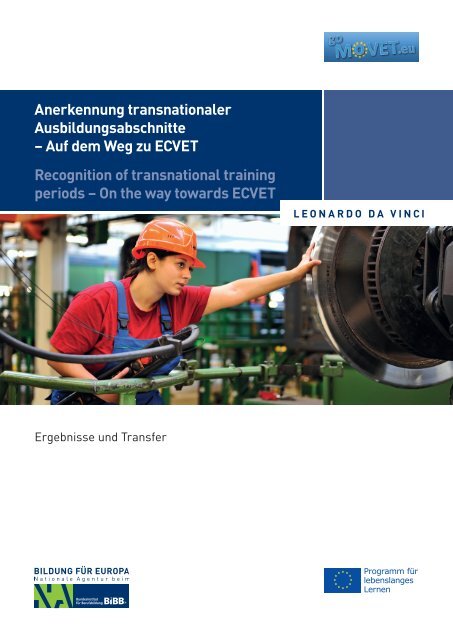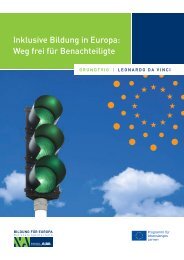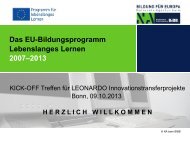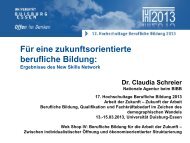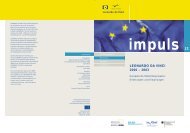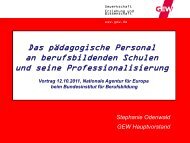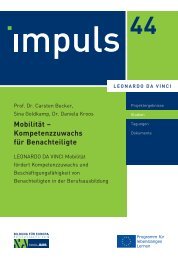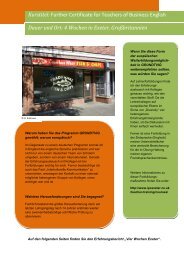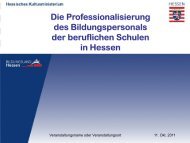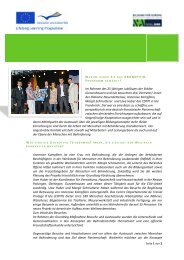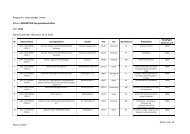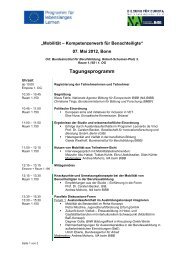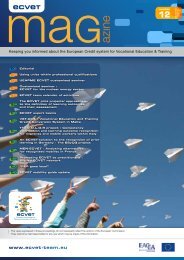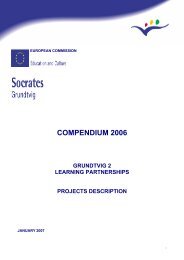als PDF-Datei zum Herunterladen - NA-BIBB
als PDF-Datei zum Herunterladen - NA-BIBB
als PDF-Datei zum Herunterladen - NA-BIBB
Erfolgreiche ePaper selbst erstellen
Machen Sie aus Ihren PDF Publikationen ein blätterbares Flipbook mit unserer einzigartigen Google optimierten e-Paper Software.
anerkennung transnationaler<br />
ausbildungsabschnitte<br />
– auf dem Weg zu ecVeT<br />
recognition of transnational training<br />
periods – on the way towards ecVeT<br />
Ergebnisse und Transfer<br />
Leonardo da Vinci
anerkennung europäischer Lernleistungen<br />
am Beispiel von ausbildungs-<br />
berufen im Metallbereich<br />
Das Europäische Leistungspunktesystem für die Berufsbildung (ECVET) wird zunehmend<br />
erprobt. Dieses System soll Auszubildenden Auslandsaufenthalte innerhalb ihrer<br />
Ausbildung erleichtern, und vor allem eine Anerkennung der im Ausland erreichten<br />
Lernergebnisse ermöglichen. Das LEO<strong>NA</strong>RDO DA VINCI-Innovationstransferprojekt<br />
MOVET II (Modules for Vocational Education and Training for Competences in Europe<br />
II) bietet durch seine Instrumente die Möglichkeit, die im Rahmen der beruflichen<br />
Ausbildung im Ausland erworbenen Fachkompetenzen in der entsendenden Bildungsinstitution<br />
anerkennen zu lassen. Nachdem im Vorläuferprojekt MOVET erste Einblicke<br />
und aufschlussreiche Erfahrungsberichte über die exemplarische Mobilitätsdurchführung<br />
im Bereich der Mechatroniker/-innenausbildung gewonnen werden konnten, steht in<br />
MOVET II die Anerkennung und Transparenz beruflicher Kompetenzen in Ausbildungsberufen<br />
im Metallbereich im Vordergrund.<br />
ausgangssituation<br />
Der Ausbau von personalen und sozialen<br />
Kompetenzen der angehenden Fachkräfte<br />
bei berufsbezogenen Auslandsaufenthalten<br />
(Mobilität) ist ein bedeutsamer Faktor, wenn<br />
Betriebe sich dafür entscheiden, ihre Auszubildenden<br />
ins Ausland zu entsenden. Der<br />
bisher eher vernachlässigte Zugewinn im<br />
Bereich der Fachkompetenzen birgt darüber<br />
hinaus enormes Potenzial, um die europäische<br />
Mobilität im Bereich der Berufsaus-<br />
bildung weiter auszubauen. Diese berufsfeld-<br />
eigenen Fachkompetenzen gilt es transparent<br />
darzustellen, um eine anschließende<br />
Anerkennung durch die heimische Ausbil-<br />
dungsinstitution zu ermöglichen. An diesem<br />
Punkt setzt MOVET II an und entwickelt<br />
Module und Anerkennungsinstrumente für<br />
die transnationale Qualifizierung von Beru-<br />
fen aus dem Metallbereich. Für die beteiligten<br />
Akteure hat es weiterhin einen besonderen<br />
europäischen Wert die Elemente des<br />
ECVET mit den Strukturen des Euro-<br />
päischen Qualifikationsrahmens (EQRs)<br />
zu verbinden. Daher wird zu Beginn von<br />
MOVET II festgelegt, dass alle Module nach<br />
Stufe 4 des EQR auszurichten sind. Die<br />
Niveaufestlegung auf Level 4 entspricht der<br />
Einstufung der drei- bis vierjährigen Metall-<br />
ausbildungen der teilnehmenden Länder.<br />
Vorgehensweise von MoVeT ii<br />
Für die Modulentwicklung werden zwei<br />
bewährte Zugänge gewählt. Zum einen die<br />
Analyse der Lehrpläne für Mechatroniker/<br />
-innen aus Deutschland und den beteiligten<br />
Partnerländern, Dänemark, Finnland und<br />
Slowakei, um geeignete Inhalte für transnationale<br />
Module zu finden. Zum anderen bezieht<br />
sich das Projekt auf das VQTS-Modell<br />
(Vocational Qualification Transfer System)<br />
und verwendet die Kompetenzmatrix für<br />
Mechatroniker/-innen und die analog<br />
daraus im MOVET II Projekt entwickelte<br />
Matrix für Industriemechaniker/-innen.<br />
Das VQTS-Modell verwendet ein systematisches<br />
Verfahren zur Beschreibung<br />
arbeitsbezogener Kompetenzen und dient<br />
den Berufsschulen aus den vier Ländern<br />
<strong>als</strong> gemeinsamer Ausgangspunkt für die<br />
Entwicklung von Modulen. Die englischsprachigen<br />
Module sind speziell für den<br />
transnationalen Austausch konzipiert und<br />
einheitlich nach Lernergebnissen aufgebaut.<br />
Zielgruppe für die jeweils dreiwöchigen<br />
Lerneinheiten sind Auszubildende<br />
im zweiten und dritten Lehrjahr. Die sechs<br />
Qualifizierungsmodule zur Automatisie-<br />
rungstechnik, die im Rahmen von transnationaler<br />
Mobilität erprobt wurden, sind:<br />
Bus Systeme in Kopenhagen,<br />
Bus Systeme in Pori,<br />
CAD/CAM (Computergestützte<br />
Formgebung und Fertigung) in Weiden,<br />
CNC (Computergestützte numerische<br />
Steuerung) in Spišská Nová Ves,<br />
E-Pneu (Elektropneumatische<br />
Steuerung) in München,<br />
Hydraulik in Kopenhagen und<br />
SPS (Speicherprogrammierbare<br />
Steuerung) in München.<br />
MOVET II sticht wie das Vorgängerprojekt<br />
vor allem damit hervor, diese Ergebnisse<br />
innerhalb der Projektlaufzeit praktisch<br />
erprobt zu haben. Schüler/-innen aus allen<br />
vier Ländern nehmen an den Modulen und<br />
den abschließenden Prüfungen teil. Eigens<br />
entworfene Leitlinien zur Validierung von<br />
Lernergebnissen, zur Formulierung eines<br />
Memorandum of Understanding sowie<br />
zur Durchführung von Mobilität helfen<br />
bei der Umsetzung. Das Memorandum of<br />
Understanding, verstanden <strong>als</strong> Absichtserklärung<br />
zwischen den Bildungspartnern,<br />
fixiert Vereinbarungen über die während<br />
des Auslandsaufenthaltes zu erwerbenden<br />
Kompetenzen, über das während dieser<br />
Zeit angebotene Ausbildungsprogramm,<br />
die Namen der Kontaktpersonen sowie die<br />
Verantwortlichkeiten der Beteiligten. Die<br />
Rahmenbedingungen für Mobilität nach<br />
ECVET-Kriterien sind somit für alle beteiligten<br />
Partner transparent.<br />
anerkennung durch Transparenz<br />
Eine Anerkennung der erworbenen Fach-<br />
kompetenzen im Ausland durch die heimischen<br />
Bildungsinstitutionen kann nur<br />
erfolgen, wenn die Inhalte der Lernstrecke,<br />
sowie des Prüfungsanspruchs hinreichend
transparent, und damit zugleich nachvollziehbar,<br />
sind. MOVET II geht hier einen<br />
weiteren Schritt in Richtung Realisierung<br />
eines ECVET. Dafür sind eigens entwickelte<br />
und mehrteilige Kompetenzfeststellungsver-<br />
fahren notwendig. Das Prüfungsverfahren<br />
ist auf die Lernergebnisse abgestimmt und<br />
lässt sich anhand der vom Lehrstuhl für<br />
Pädagogik der Technischen Universität<br />
München entwickelten Taxonomie Tabelle<br />
beurteilen. Der Leistungsnachweis unter-<br />
gliedert sich in einen theoretischen und<br />
einen praktischen Prüfungsteil, sowie einem<br />
abschließenden Fachgespräch zwischen Aus-<br />
zubildendem und Fachbetreuer/-in. Nach<br />
erfolgreicher Absolvierung der Moduleinheit<br />
erhalten die Teilnehmer/-innen ein<br />
Zertifikat <strong>als</strong> Nachweis für die entsendende<br />
Bildungseinrichtung.<br />
die Taxonomie Tabelle von MoVeT – ein<br />
transparenzförderndes instrument<br />
Durch die Aufschlüsselung der gesamten<br />
Lernstrecke in konkrete Lernergebnisse<br />
werden die vermittelten Inhalte der o.g.<br />
sechs Module für die Partnerinstitutionen<br />
transparent. Um eine optimierte Einstufung<br />
des fachlichen Niveaus der angebotenen<br />
Module der ausländischen Berufsschulen<br />
vornehmen zu können, entwickelt MOVET<br />
die Taxonomie Tabelle. Diese stellt die Basis<br />
für die Zusammenarbeit der beteiligten<br />
Bildungsinstitutionen dar. Sie bereitet den<br />
Weg für eine inhaltliche Anerkennung von<br />
national unterschiedlichen Ausbildungen<br />
und für das Vertrauen in das jeweils individuelle<br />
Prüfungsvorgehen. Denn jedes<br />
einzelne Lernergebnis kann in dieser Tabelle<br />
verortet und durch seinen Zahlencode<br />
identifiziert werden. Die damit erreichte<br />
Visualisierung der Komplexitätsniveaus<br />
ermöglicht den transnationalen Bildungsakteuren<br />
einen optimierten Einblick in den<br />
Bildungsanspruch des Moduls. Der Grad<br />
der Anerkennung erfolgt dementsprechend<br />
nach Einschätzung der heimischen Bildungs-<br />
institutionen.<br />
ausblick<br />
Die Fortsetzung der erarbeiteten Ansätze<br />
und Instrumente aus den beiden LEO<strong>NA</strong>RDO<br />
DA VINCI-Innovationstransferprojekten<br />
MOVET und MOVET II erfolgt ab Oktober<br />
2012 über die reguläre Beantragung von<br />
Mobilität bei den jeweiligen Nationalen<br />
Agenturen der teilnehmenden Länder.<br />
The MoVeT model<br />
Knowledge<br />
Cognitive<br />
Process<br />
Factual<br />
knowledge<br />
Causal<br />
knowledge<br />
Procedural<br />
knowledge<br />
recognition<br />
The taxonomy table<br />
Analysis of<br />
Curricula<br />
Remember<br />
Compe-<br />
tence Matrix<br />
Description<br />
of Learning<br />
Outcomes<br />
Competence<br />
Assessment<br />
Modules<br />
ECVET<br />
Die aktuellen Partner sind derzeit im<br />
Gespräch mit weiteren Berufsschulen in verschiedenen<br />
Ländern, um eine Ausweitung<br />
des Netzwerks zu prüfen. Wünschenswert<br />
ist dabei eine Öffnung gegenüber weiteren<br />
Berufsbildern. Die Kompetenzmatrix soll<br />
dabei eine bedeutende Hilfestellung darstellen.<br />
Ebenso wird die Wirksamkeit und<br />
berufsübergreifende Anwendbarkeit der<br />
Taxonomie Tabelle weiter wissenschaftlich<br />
untersucht. Das zentrale Ziel bleibt die<br />
Anerkennung durch Transparenz in der<br />
europäischen Berufsbildung zu ermöglichen.<br />
Go MOVET!<br />
Memorandum<br />
of Under-<br />
standing<br />
www.gomovet.eu<br />
Mobility<br />
Transparency<br />
graphic: Dr. Edda Fiebig<br />
Understand Apply Analyze Evaluate Create
ecognition of european learning<br />
outcomes using the example of<br />
skilled occupations in the met<strong>als</strong><br />
sector<br />
The European Credit system for Vocational Education and Training (ECVET) is<br />
being increasingly tested in practice. This system is intended to facilitate students´<br />
periods spent abroad as part of their training, and above all enable recognition of<br />
learning outcomes attained abroad. Through its instruments, the LEO<strong>NA</strong>RDO DA<br />
VINCI transfer of innovation project MOVET II (Modules for Vocational Education<br />
and Training for Competences in Europe II) offers the possibility of having technical<br />
competences – which have been acquired within the scope of professional training<br />
abroad – recognised by the home training institution. After having acquired from<br />
the forerunner-project MOVET initial insights and informative progress reports<br />
concerning exemplary implementation of mobility in the training sector of mechatronics<br />
technicians, the focus in MOVET II is on recognition and transparency of<br />
vocational competences in skilled occupations in the met<strong>als</strong> sector.<br />
initial situation<br />
The development of personal and social<br />
competences of future skilled employees<br />
from work-related periods abroad (mobility)<br />
is a significant factor when companies<br />
decide to send their students abroad. The<br />
gain in the technical expertise sector has<br />
been somewhat neglected up to now, but it<br />
harbours in addition enormous potential<br />
for further developing European mobility<br />
in the vocational training sector. It is necessary<br />
to present these vocational-fieldspecific<br />
technical competences trans-<br />
parently, in order to enable a subsequent<br />
recognition by the home training institu-<br />
tion. MOVET II takes this as its starting<br />
point and develops modules and recognition<br />
instruments for the transnational<br />
qualification of professions within the<br />
met<strong>als</strong> sector. For the participants concerned,<br />
there is moreover a particularly<br />
European value in linking the elements of<br />
ECVET to the structures of the European<br />
Qualifications Framework (EQF). It will<br />
therefore be specified at the beginning<br />
of MOVET II that all modules are to be<br />
aligned to EQF level 4. Setting the niveau<br />
at level 4 corresponds to the categorisation<br />
of the three to four year met<strong>als</strong> training pro-<br />
grammes of the participating countries.<br />
MoVeT ii – Procedural method<br />
Two approved approaches are selected for<br />
module development. Firstly, analysis of<br />
the curricula is undertaken for mechatronics<br />
technicians from Germany and<br />
the participating partner-countries of<br />
Denmark, Finland and Slovakia, in order<br />
to find suitable content for transnational<br />
modules. Secondly, the project relates to<br />
the VQTS-model (Vocational Qualification<br />
Transfer System) and utilises the<br />
competence matrix for mechatronics<br />
technicians and the matrix for mechanics<br />
in industry analogous with the one<br />
developed in the MOVET II project. The<br />
VQTS-model utilises a systematic process<br />
for the description of work-related competences<br />
and benefits the vocational schools<br />
from the four participating countries as a<br />
common starting point for the development<br />
of modules. The English-language<br />
modules are specially conceived for trans-<br />
national exchange and uniformly structured<br />
according to learning outcomes. The<br />
target group for the three-week learning<br />
units in each case are students in their<br />
second and third year of training. The six<br />
qualification modules for automation<br />
technology, which have been tested within<br />
the scope of transnational mobility, are:<br />
Bus systems in Copenhagen,<br />
Bus systems in Pori,<br />
CAD/CAM (Computer-aided design<br />
and manufacturing) in Weiden,<br />
CNC (Computer numerical control)<br />
in Spišská Nová Ves,<br />
E-Pneu (Electro-pneumatic control)<br />
in Munich,<br />
Hydraulics in Copenhagen and<br />
PLC (Programmable logic control)<br />
in Munich,<br />
MOVET II stands out particularly by<br />
having tested these results in practice<br />
within the project’s duration. Students<br />
from all four participating countries take<br />
part in the modules and the concluding<br />
examinations. Specially designed guide-<br />
lines for the validation of learning outcomes,<br />
for formulating a Memorandum of<br />
Understanding as well as for the development<br />
of mobility help in implementation.<br />
The Memorandum of Understanding, recognised<br />
as a declaration of intent between<br />
the training institute partners, sets out<br />
agreements on competences which are to<br />
be achieved during the period of training<br />
abroad, on the training programme offered<br />
during this period, the names of contact<br />
persons, as well as responsibilities of the<br />
participants. The framework conditions<br />
for mobility according to ECVET criteria<br />
are thus transparent for all participating<br />
partners.<br />
recognition through transparency<br />
A recognition by the home training institutions<br />
of technical competences attained<br />
abroad can only take place if the<br />
continued on page 6
Projekttitel / Project Title:<br />
MOVET II – Modules for<br />
Vocational Education and Training for<br />
Competences in Europe II<br />
Projektnummer / Project number:<br />
DE/10/LLP-LdV/TOI/147341<br />
Projektdauer / Project duration:<br />
01.10.2010–30.09.2012<br />
Vertragnehmer / contractor:<br />
Lehrstuhl für Pädagogik,<br />
TU München, Deutschland<br />
Partner / Partners:<br />
Berufsschule für Fertigungstechnik<br />
München (BSFT), München (DE)<br />
BMW Group, München (DE)<br />
Europa-Berufsschule Weiden,<br />
Weiden (DE)<br />
European Forum for Technical and<br />
Vocational Education and Training<br />
(EfVET), Brussels (BE)<br />
IHK München und Oberbayern,<br />
München (DE)<br />
Industriens Uddanelser,<br />
Copenhagen (DK)<br />
MTU Aero Engines, München (DE)<br />
National Centre for Vocational<br />
Education (NCE), Frederiksberg (DK)<br />
Seidenader Maschinenbau GmbH,<br />
Markt Schwaben (DE)<br />
Stadtwerke München (SWM),<br />
München (DE)<br />
Technická akadémia,<br />
Spišská Nová Ves (SK)<br />
Teknisk Erhvervsskole Center Copen-<br />
haven (TEC), Frederiksberg (DK)<br />
Úrad Košického samosprávneho kraja,<br />
Košice (SK)<br />
WinNova, Länsirannikon Koulutus Oy,<br />
Pori (FI)<br />
Kontakt / contact:<br />
Laura Flacke<br />
Dr. Markus Müller<br />
Prof. Dr. Andreas Schelten<br />
Lehrstuhl für Pädagogik<br />
Technische Universität München<br />
Lothstr. 17<br />
80335 München<br />
Germany<br />
E-Mail: flackel@gomovet.eu<br />
muellerm@gomovet.eu<br />
scheltena@gomovet.eu<br />
internetseite / Website:<br />
www.gomovet.eu<br />
http://www.adam-europe.eu/<br />
adam/project/view.htm?prj=7093<br />
Produktbeschreibung/ergebnisse<br />
Zielgruppe:<br />
Berufsbildungseinrichtungen, Ausbilder/<br />
-innen und Auszubildende im Sektor<br />
Mechatronik, Industriemechanik und in<br />
artverwandten Bereichen<br />
Produkte:<br />
1. Modulbeschreibungen der sechs Lerneinheiten:<br />
E-Pneu, SPS, Hydraulik,<br />
Bus Systeme, CNC und CAD/CAM<br />
Sprache: EN<br />
Auflistung aller Lernergebnisse, Arbeitsmaterialien<br />
für eine dreiwöchige Moduldurchführung,<br />
Prüfungsunterlagen<br />
2. Leitlinien<br />
Sprache: DE, EN<br />
a) Durchführung von Mobilitäten im<br />
Rahmen von LEO<strong>NA</strong>RDO DA<br />
VINCI<br />
b) Umsetzung des Memorandum<br />
of Understanding aus VQTS<br />
c) Formulierung von Lernergebnissen<br />
und deren Einstufung in die<br />
Taxonomie Tabelle<br />
3. Forschungsbericht MOVET<br />
Sprache: DE, EN<br />
4. Taxonomie Tabelle mit erläuterndem<br />
Informationsfolder<br />
Sprache: DE, EN<br />
Transparenzförderndes Instrument<br />
zur Verortung von Lernergebnissen<br />
5. Kompetenzmatrix für Industrie-<br />
mechaniker/-innen mit erläuterndem<br />
Informationsfolder<br />
Sprachen: DE, EN<br />
Die Produkte können über den Vertragnehmer/Contractor<br />
angefordert werden.<br />
Product/result description<br />
Target group:<br />
Vocational education institutions,<br />
instructors and students in the mechatronics,<br />
and related fields<br />
Products:<br />
1. Module descriptions of the six learning<br />
units: E-Pneu, PLC, Hydraulics, Bus<br />
systems, CNC and CAD/CAM<br />
Language: EN<br />
Listing of all learning outcomes, work<br />
materi<strong>als</strong> for implementation of a<br />
three-week module, examination<br />
documents<br />
2. Guidelines for<br />
Languages: DE, EN<br />
a) implementation of mobility<br />
within the scope of LEO<strong>NA</strong>RDO<br />
DA VINCI<br />
b) realisation of the Memorandum<br />
of Understanding from the VQTS<br />
c) formulation of learning outcomes<br />
and their classification into the<br />
taxonomy table<br />
3. Research report MOVET<br />
Languages: DE, EN<br />
4. Taxonomy table with explanatory<br />
information folder<br />
Languages: DE, EN<br />
A transparency-enhancing instrument<br />
for the location of learning outcomes<br />
5. Competence matrix for mechanics in<br />
industry with explanatory information<br />
folder<br />
Languages: DE, EN<br />
Products can be ordered from the<br />
contractor.
impressum<br />
Nationale Agentur<br />
Bildung für Europa<br />
beim Bundesinstitut für<br />
Berufsbildung (<strong>NA</strong> beim <strong>BIBB</strong>)<br />
Robert-Schuman-Platz 3<br />
53175 Bonn<br />
www.na-bibb.de<br />
Verantwortlich (i.S.d.P.):<br />
Klaus Fahle<br />
Text: Laura Flacke,<br />
Dr. Markus Müller,<br />
Prof. Dr. Andreas Schelten<br />
Fotos: Stadtwerke München,<br />
Laura Flacke<br />
Gestaltung: kippconcept GmbH<br />
Umsetzung: Pia Reiserer<br />
Druck: WIRmachenDRUCK GmbH<br />
München, August 2012<br />
Europäische Projekt- und<br />
Produktdatenbank ADAM:<br />
www.adam-europe.eu<br />
Bestellhinweise: Dieses Infoblatt kann<br />
kostenlos beim Lehrstuhl für Pädagogik<br />
der TU München angefordert werden.<br />
Das Projekt MOVET wurde mit Unter-<br />
stützung der Europäischen Kommission<br />
finanziert. Die Verantwortung für den Inhalt<br />
dieser Veröffentlichung trägt allein der<br />
Verfasser; die Kommission haftet nicht<br />
für die weitere Verwendung der darin<br />
enthaltenen Angaben.<br />
die nationale agentur Bildung für europa<br />
Die Nationale Agentur Bildung für Europa beim Bundesinstitut für Berufsbildung<br />
(<strong>NA</strong> beim <strong>BIBB</strong>) besteht seit dem Jahr 2000 und arbeitet im Auftrag und mit finanzieller<br />
Förderung des Bundesministeriums für Bildung und Forschung (BMBF). Sie ist Nationale<br />
Agentur für das Europäische Bildungsprogramm für lebenslanges Lernen (2007–2013) in<br />
Deutschland und betreut in dieser Funktion die Einzelprogramme LEO<strong>NA</strong>RDO DA VINCI<br />
für die Berufsbildung und GRUNDTVIG für den Bereich der Erwachsenenbildung. Die<br />
<strong>NA</strong> beim <strong>BIBB</strong> ist ferner Nationales Europass Center sowie Nationale Koordinierungsstelle<br />
ECVET und nimmt verschiedene europabezogene Sonderaufgaben wahr.<br />
continued from page 4<br />
content of the learning path, as well as of<br />
the examination entitlement are sufficiently<br />
transparent, and thus at the same time<br />
reasonable. Here, MOVET II takes a further<br />
step towards realising an ECVET. Specially<br />
developed and multi-staged competencedefining<br />
processes are therefore necessary.<br />
The examination process is coordinated<br />
with the learning outcomes and can be<br />
evaluated via the taxonomy table developed<br />
by the Department of Pedagogy at the<br />
Technische Universität München. Course<br />
assessment is subdivided into a theoretical<br />
and a practical examination part, as well as<br />
a concluding technical discussion between<br />
students and their supervisor. After successful<br />
completion of the modular unit, the participants<br />
receive a certificate as a means of<br />
verification for their home training institute.<br />
The MoVeT taxonomy table – a transparency-enhancing<br />
instrument<br />
By breaking down the entire learning path<br />
into concrete learning outcomes, the imparted<br />
content of the six above-named modules<br />
becomes quite transparent for the partner<br />
institutions. In order to be able to perform an<br />
optimized classification of the technical level<br />
of the modules offered by the foreign vocational<br />
schools, MOVET has developed the<br />
taxonomy table. This represents the foundation<br />
for the collaboration of the participating<br />
educational institutions. It prepares the way<br />
for a recognition of content in nationally<br />
varying training courses and for mutual<br />
trust in the individual examination procedure<br />
in each case. Indeed, each individual<br />
learning outcome can be located in this table<br />
and identified through its numerical code.<br />
The visualisation of the level of complexity<br />
thus obtained enables the transnational<br />
education partners an optimised insight into<br />
the educational aspirations of the module.<br />
The degree of recognition follows according<br />
to the assessment of the home educational<br />
institutions.<br />
outlook<br />
From October 2012, the continuation of<br />
the acquired approaches and instruments<br />
from both of the LEO<strong>NA</strong>RDO DA VINCI<br />
transfer of innovation projects MOVET<br />
and MOVET II ensues via the regular appli-<br />
cation of mobility at the relevant national<br />
agencies of the participating countries. The<br />
current partners are presently involved in<br />
discussions with further vocational schools<br />
in various countries in order to consider<br />
expansion of the existing network. The<br />
opening up of the scheme to further job<br />
profiles would be desirable. The competence<br />
matrix could thus be expected to render<br />
considerable support. In the same way, the<br />
effectiveness and inter-professional application<br />
of the taxonomy table will be further<br />
scientifically examined. The central aim<br />
is still to facilitate recognition through<br />
transparency in European vocational<br />
education. Go MOVET!


